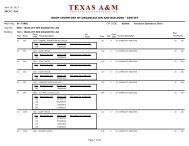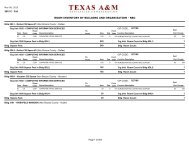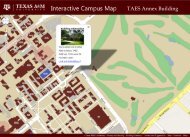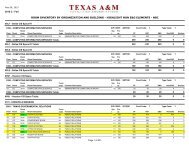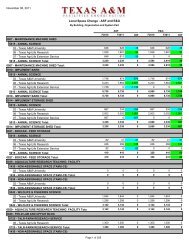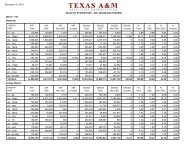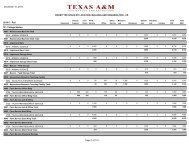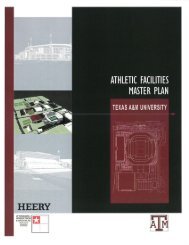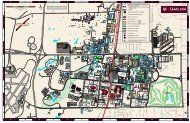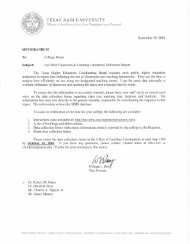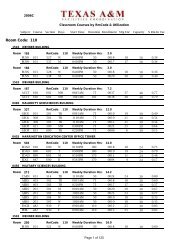Riverside Campus Plan - Office of Facilities Coordination - Texas ...
Riverside Campus Plan - Office of Facilities Coordination - Texas ...
Riverside Campus Plan - Office of Facilities Coordination - Texas ...
- No tags were found...
You also want an ePaper? Increase the reach of your titles
YUMPU automatically turns print PDFs into web optimized ePapers that Google loves.
COMPONENTS OF THE CAMPUS PLAN39standard. A comprehensive study undertaken bythe engineering firm <strong>of</strong> Burns and McDonnell forUEM recommends that <strong>Texas</strong> A&M Universityaim for en energy efficiency standard 20% betterthan the 2010 ASHRAE. Such a target wouldrequire higher first cost expenditures, but in mostcases a lower life cycle cost is achieved, togetherwith significant environmental benefits throughreduced energy consumption. Application <strong>of</strong> energystandards should relate to use and cost effectiveness.FIGURE 5This example <strong>of</strong> a solar panelsculpture, seen here at YellowstoneNational Park, is a greatsolution to energy managementon research pastures.The original campuses in College Station haveachieved very significant savings with the installation<strong>of</strong> a Combined Heat and Power (CHP) systemwith centrally distributed heating and cooling.With the opportunity to see the <strong>Riverside</strong> <strong>Campus</strong>as a ‘new’ installation a CHP system should beconsidered. In addition some or all <strong>of</strong> the followingdesign and technology alternatives would <strong>of</strong>ferfurther efficiencies, though as with any projectdesign a balance must be drawn between firstand life-cycle costs.•Building envelopes must have high insulationvalues•Natural light and building orientation mustbe used effectively•Geothermal systems should be explored forsupplemental cooling and heating5•High efficiency HVAC and lighting design withintelligent building automation for optimized control<strong>of</strong> both HVAC and lighting•Heat/cooling recovery systems should be incorporatedwhen extensive outside air is required•Solar energy technology should be consideredfor hot water and supplemental electrical supply•Low water use plumbing fixtures and the use <strong>of</strong>gray water and water recovery from ro<strong>of</strong>s andHVAC cooling coilsThe integration <strong>of</strong> current Utilities and EnergyManagement (UEM) experience with the on-goingresearch at the <strong>Riverside</strong> <strong>Campus</strong> Energy EfficiencyLaboratory (REEL) <strong>of</strong>fers a unique opportunityfor innovation and the use <strong>of</strong> grant fundingto develop on-campus, full-scale demonstrationprojects.



